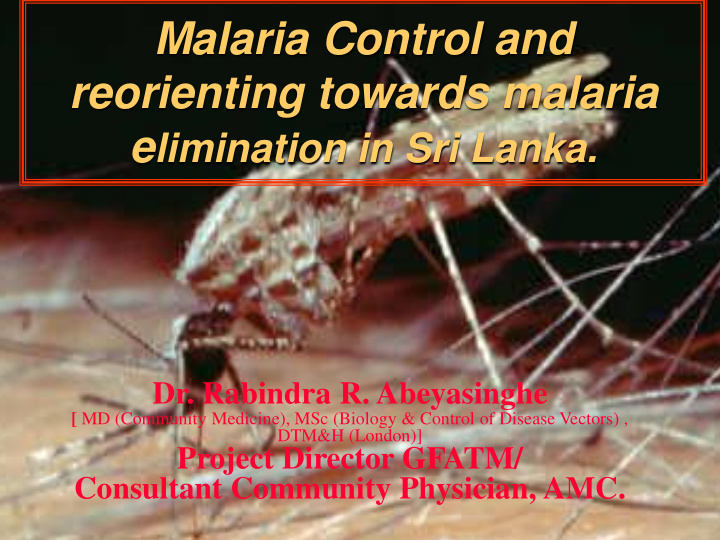



Malaria Control and reorienting towards malaria e limination in Sri Lanka. Dr. Rabindra R. Abeyasinghe [ MD (Community Medicine), MSc (Biology & Control of Disease Vectors) , DTM&H (London)] Project Director GFATM/ Consultant Community Physician, AMC. 03/05/2010 Anti Malaria Campaign Directorate 03/05/2010 Anti Malaria Campaign Directorate 1
Year No. of Blood No. of positive P.v. P.f. smears cases examined and RDT tests 1999 1582111 264549 200671 63878 2000 1781372 210039 150389 59650 2001 1353386 66522 55922 10600 2002 1387953 41411 36535 4876 2003 1192259 10510 9237 1273 2004 1198181 3720 3171 549 2005 973861 1640 1506 134 2006 1076121 591 564 27 2007 1021911 196 189 7 2008 1047104 670 623 46
Malaria control Objective Reduce the disease burden as much as possible in a cost effective manner utilizing available resources. Result Reduction of disease burden over a ten year period, since 1998 with over a 50% saving on supplies. 03/05/2010 Anti Malaria Campaign Directorate
Malaria elimination An intensified time limited programme aiming at interrupting and preventing the further transmission of malaria in a country by the end of a defined period and maintaining the malaria free status Target – Elimination by year 2015 03/05/2010 Anti Malaria Campaign Directorate
District-wise distribution of microscopically confirmed malaria patients in 110 130 150 -10 10 30 50 70 90 Colombo 03/05/2010 Gampaha Kalutara Kandy Matale N'Eliya Galle Matara Hambantota Sri Lanka – 2008. Anti Malaria Campaign Directorate Jaffna Kilinochchi Vavuniya Mannar Mullativu Batticaloa Ampara Kalmune Trincomalie Kurunegala Maho Puttalam Anuradhapura Polonnaruwa Badulla Moneragala Ratnapura Kegalle
Trends in Malaria 1998 - 2007 300050 264549 270050 240050 210039 210050 Microscopically confirmed malaria cases 180050 150050 120050 90050 66522 60050 41411 30050 10510 3720 1640 591 670 196 50 1999 2000 2001 2002 2003 2004 2005 2006 2007 2008
Trend in Malaria 1999 - 2008 300000 250000 200000 150000 100000 50000 0 1999 2000 2001 2002 2003 2004 2005 2006 2007 2008
Mortality due to malaria in Sri Lanka Reported mortality Year 2000 76 Year 2001 58 Year 2002 30 Year 2003 04 Year 2004 01 Year 2005 00 Year 2006 00 Year 2007 01 Year 2008 00 03/05/2010 Anti Malaria Campaign Directorate
Areas for malaria elimination Jaffna Non-conflict districts Transition districts Kilinochchi Mullativu Conflict affected districts MannarVavuniya Anuradhapura Trincomalie Polonnaruwa Puttalam Batticaloa Kurunegala Matale Kandy Kalmune Gampaha Kegalle Ampara Badulla Colombo N’Eliya Moneragala Kalutara Ratnapura Galle Hambantota 03/05/2010 Anti Malaria Campaign Directorate Matara
Objectives of the Anti Malaria Campaign To eliminate indigenous P. falciparum malaria by the year 2012 in non-conflict & transitional areas of the country. To eliminate indigenous P. vivax malaria by the year 2012 in 75% of non-conflict & transitional areas of the country To reduce API in conflict affected areas to 75% of the API reported in 2007, by the year 2012. To maintain zero mortality from malaria in Sri Lanka 03/05/2010 Anti Malaria Campaign Directorate
Methodology Strengthen surveillance Radical cure of all patients/carriers Enhanced vector control Prevention of introduction Increased awareness 03/05/2010 Anti Malaria Campaign Directorate
Strengthening the surveillance system Increasing and improving the capacity of the system to detect early new cases of malaria Ensuring radical cure of all cases and to prevent secondary cases Detecting early increases in vector densities and changes in vector bionomics that could contribute to malaria Improving programme management and enhancing cost effectiveness 03/05/2010 Anti Malaria Campaign Directorate
Thank you. . 03/05/2010 Anti Malaria Campaign Directorate
Recommend
More recommend